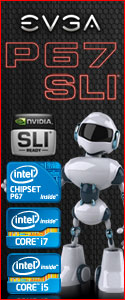Now it’s time to find out how actually putting a system together inside the V3 Black Edition works out. Given our cable management concerns discussed above, we do have some other things working in our favor. First we have a modular power supply which should aid in tidying things up, and we’ll be using a mATX form factor motherboard. Working against us is our desire to install a crossfire setup using two HD3870 video cards. Lets see how it worked out shall we?
First up was to install the SATA DVD Rom drive along with a SATA hard drive, no problems here. We used the “Twist to Lock” knobs on one side of each drive and just for added security we added a single mounting screw to the opposite side of the bays.
 |
 |
 |
 |
After installing the I/O shield we set out to mount the motherboard. Mounting a mATX motherboard required installing a few brass standoffs, we noticed that each mounting hole was marked with a letter letting you know where a standoff should go for each form factor. With CPU cooler (Thermaltake Frio) and memory pre-installed. We carefully laid the motherboard in to position and secured it in place with the provided screws. We did notice however that the rear most center hole in the motherboard did not have a corresponding hole to mount to, nor was there any accommodation for a standoff in the motherboard mounting surface.
 |
 |
Next we grabbed a couple of Visiontek HD3870 graphics cards and installed those. Thermaltake has implemented a pretty slick design for attaching add on cards. There is a plate on the back side of the case that covers the area where you screw down the add on card brackets. You remove this cover plate with just a single screw, and secure your add on cards with a screw. What makes the design so nice is the fact that you can access the screws outside the rear of the case, which means getting to the screws is extremely easy. Also we noticed that Thermaltake’s specification for the V3 Black Edition list video card compatibility up to 10.4 inches, we think they are selling themselves a bit short, our measurements were closer to 12 inches.
Here is a picture of the video cards installed, it gives you a good look at the openness of the area when installing the cards. Once done simply re-attach the bracket over your mounting area.
Next up was the power supply installation, super easy installation here and plenty of room to work. We ran in to one small issue regard the mounting holes, only three of the four lined up correctly. Three is plenty to hold it secure but it was a tad odd. We laid the power supply filter in place and installed a Thermaltake Toughpower XT 775 watt unit.
 |
 |
We spent a while figuring out the best way to rout wires and the such. We would definitely recommend using a modular power supply with this case as the wire management options are limited at best. Luckily there is quite a bit of room to the right side of the 3.5″ drive bay housing to tuck cables away. There are also some exposed motherboard mounting risers available to use for wire tying, if a mATX motherboard is being installed. All in all we think it came out pretty nice looking. One other issue we ran in to was attempting to mount a fan under the top panel’s forward location. A 25mm thick fan would not fit as it hit the memory retention clips. We measured a couple other motherboards we had laying around, and had they been used instead, the same issue would have happened. A mere 1/4″ more room there would have been sufficient to get the fan mounted. 120mmX20mm and 120mmX12mm fans are available and I would venture to say either of those sizes would fit. Here is a gallery of the finished build.
 |
 |
|
 |
 |
 |
 |
 |
 |
 |
 |
 |


 Posted in
Posted in 





